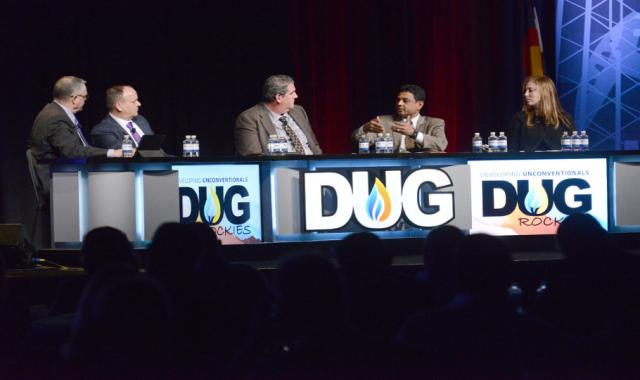
Hart Energy’s Richard Mason (left) moderates a tech panel featuring Mark Pearson, Liberty Resources; Paul Favret, Resource Energy Partners; Kumar Ramurthy, Halliburton; and Amanda Seholm, Baker Hughes Inc., at DUG Bakken and Niobrara. (Source: Hart Energy)
Learn more about Hart Energy Conferences
Get our latest conference schedules, updates and insights straight to your inbox.
DENVER—The energy industry has proven its mettle again and again, finding ways to survive downturns by becoming more nimble and efficient. Nowhere has this been more obvious than in the unconventional plays.
At Hart Energy’s recent DUG Bakken & Niobrara conference, a panel of experts including Mark Pearson, president of Liberty Resources LLC; Paul Favret, CEO of Resource Energy Partners; Kumar Ramurthy, technology director-Rockies for Halliburton (NYSE: HAL); and Amanda Seholm, director of geoscience and petroleum engineering for North America at Baker Hughes (NYSE: BHI); discussed the next steps in the shale juggernaut.
The modus operandi for the past couple of years has been slickwater fracs with lots of proppant loading. And, according to Favret, the move to slickwater was originally just an attempt to save money.
“A lot of people aren’t aware of that,” he said. “People were saying, ‘Gas prices are low. How do we make a living? How do we grow our companies? How do we sustain our production?’ What they found was that by dropping costs and focusing on slickwater, they effectively reached a lot more of the rock volume. And the results of that were, quite frankly, spectacular.”
Ramurthy added that the combination of slickwater fracs and massive proppant volumes made the difference.
“The trend that we are seeing now is that with more increase in slurry volume, and obviously you need slickwater to carry the proppant, we found out that production is high in liquid, but it’s not necessary hydrocarbons,” he said. “So I would focus more on the proppant volume.”
So did companies move toward higher proppant loading just because sand was cheap? And will rising oil prices, and thus service and supply costs, cause them to rethink their strategy?
“We definitely make decisions based on economics,” Seholm said. “Slickwater made a lot of sense. There were ways to create a ‘poor man’s gel’ by upping our friction reducer loadings. But if we’re able to do the analysis and better understand how those wells are producing to offset wells, I think it will be able to come into balance.”
Ramurthy cited a report indicating that 40% of the cost savings during the downturn was due to service price sector reduction and another 35% was due to operators high-grading their acreage. The remainder was a combination of scaling the learning curve and improving operational efficiencies.
“With [75%] being attributable to service sector price reduction and acreage high-grading, in my opinion that’s cyclical; that’s not structural,” he said. “That’s going to change as operators move from sweet spots to other areas.
“You can’t pump those high-loading jobs everywhere. People don’t do that in the fringe acreage.”
For Pearson, the ability to work in North Dakota rather than Texas has its advantages. He said that his company has completed fewer than 200 wells in the Bakken over the past eight years, but it has access to a database of 12,000 individual wells.
“The beauty in the Bakken is that as a small company, we can analyze all of these wells. And what we’ve found is that the Bakken really has and continues to be the leader in unconventional completions.
“If you would do single-variant analysis, there are two parameters that really drive this: the amount of proppant and the number of stages. But when you get into multivariant analysis and look at geo factors, other completions factors, how well the well was drilled, where it was landed and so forth, there’s a whole slew of parameters that goes into it. So consequently, as an industry we are on a constant learning curve.”
Seholm agreed that better business analytics can help determine why one well performs better than another. Baker has compared optimized wells, that is, wells that have taken into account geological variations and have adjusted the completions strategy accordingly, with wells that were completed in a simple geometric pattern.
“We’re seeing that there truly is a difference,” she said. “I think you really have to do the science better to understand this.”
Rhonda Duey can be reached at rduey@hartenergy.com.
Recommended Reading
Hess Corp. Boosts Bakken Output, Drilling Ahead of Chevron Merger
2024-01-31 - Hess Corp. increased its drilling activity and output from the Bakken play of North Dakota during the fourth quarter, the E&P reported in its latest earnings.
CEO: Magnolia Hunting Giddings Bolt-ons that ‘Pack a Punch’ in ‘24
2024-02-16 - Magnolia Oil & Gas plans to boost production volumes in the single digits this year, with the majority of the growth coming from the Giddings Field.
Uinta Basin: 50% More Oil for Twice the Proppant
2024-03-06 - The higher-intensity completions are costing an average of 35% fewer dollars spent per barrel of oil equivalent of output, Crescent Energy told investors and analysts on March 5.
The One Where EOG’s Stock Tanked
2024-02-23 - A rare earnings miss pushed the wildcatter’s stock down as much as 6%, while larger and smaller peers’ share prices were mostly unchanged. One analyst asked if EOG is like Narcissus.
BP Pursues ‘25-by-‘25’ Target to Amp Up LNG Production
2024-02-15 - BP wants to boost its LNG portfolio to 25 mtpa by 2025 under a plan dubbed “25-by-25,” upping its portfolio by 9% compared to 2023, CEO Murray Auchincloss said during the company’s webcast with analysts.





